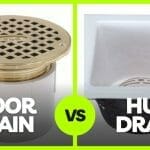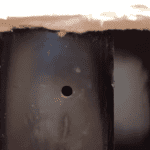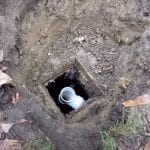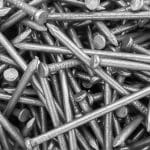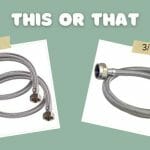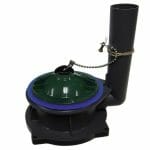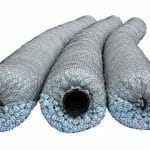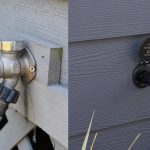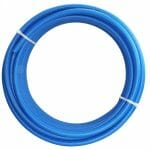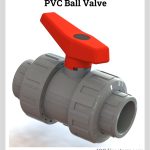Bathroom sink drain stoppers are an essential component of any sink, as they prevent water from flowing down the drain and keep the sink bowl filled with water. There are several different types of bathroom sink drain stoppers available, each with its own set of advantages and disadvantages. Here’s a closer look at the most common types:
Types of sink drain stoppers
Drop-In Drain Stoppers
Drop-in drain stoppers are among the simplest and most affordable types of sink stoppers. They consist of a small, circular plug that sits directly over the drain hole in the sink. When the plug is removed, water flows freely down the drain. To stop the water flow, the plug is simply placed back over the hole.
While drop-in drain stoppers are easy to use and install, they do have some downsides. They can become loose over time and may not provide a tight seal, which can lead to leaks. Additionally, they can be difficult to clean, as dirt and debris can become trapped around the edges of the plug.
Push-and-Pull Drain Stoppers
Push-and-pull drain stoppers are another simple type of sink stopper. They consist of a small rod that sits behind the faucet and extends down into the sink drain. To stop the water flow, the rod is pulled up, which causes a small plug at the end of the rod to cover the drain hole. To allow the water to flow again, the rod is simply pushed back down.
Push-and-pull drain stoppers are easy to use and maintain, but they may not provide a completely tight seal. Additionally, they can be difficult to remove and replace for cleaning.
Pop-Up Drain Stoppers
Pop-up drain stoppers are a more sophisticated type of sink stopper that provide a more secure seal. They consist of a rod that extends down into the sink drain and a lever that sits behind the faucet. When the lever is lifted, the rod is pulled up and a small plug at the end of the rod covers the drain hole. When the lever is lowered, the rod drops down and the plug is released, allowing the water to flow down the drain.
Pop-up drain stoppers are easy to use and provide a good seal, but they can be more difficult to install and maintain. Additionally, the lever mechanism can become damaged or stuck over time, requiring repairs or replacement.
Twist-and-Turn Drain Stoppers
Twist-and-turn drain stoppers are a more complex type of sink stopper that require a bit more effort to use. They consist of a small rod that extends down into the sink drain and a twist mechanism that sits above the move sink bowl. To stop the water flow, the user must twist the mechanism, which causes the rod to move up and a small plug at the end of the rod to cover the drain hole. To allow the water to flow again, the mechanism is simply twisted in the opposite direction.
Twist-and-turn drain stoppers provide a very tight seal and are relatively easy to maintain, but they can be more difficult to use than other types of stoppers. They also tend to be more expensive than other types of stoppers.
Overall, the choice of bathroom sink drain stopper will depend on personal preferences and the specific needs of the sink. It’s important to choose a stopper that provides a tight seal, is easy to use and maintain, and fits the style of the sink and bathroom.
conclusion
In conclusion, bathroom sink drain stoppers are an essential component of any bathroom sink. They help to prevent water from draining out of the sink, and they also play a role in maintaining hygiene by preventing hair, debris, and other objects from entering the drain. There are several types of bathroom sink drain stoppers available on the market, including pop-up drain stoppers, push-pull drain stoppers, lift and turn drain stoppers, toe-touch drain stoppers, and flip-it drain stoppers. Each type has its own unique features, benefits, and maintenance requirements. By choosing the right type of drain stopper for your bathroom sink, you can ensure efficient drainage, prevent clogs, and maintain optimal hygiene in your bathroom.
Latest Posts
- Hub Drain vs Floor Drain: What You Need to Know

- 20 Types of Plumbing Systems: Everything You Need to Know

- SUNGATOR Vs SharkBite: What’s the Difference?

- 10 DIY Plumbing Repairs That You Can Fix Yourself

- Accidentally drilled hole in PVC drain pipe – [Step By Step Repairing]

- What Is Septic Tank Baffle? How It Works – A Complete Guide

- Plumbing Vent Through Exterior Wall

- Water Heater Expansion Tank Leaking: Tips to Fix

- Can I Use 3 Inch Nails for Framing? Essential Tips and Guidelines

- 1/2 Or 3/4 Water Supply Line: Choosing the Perfect Fit for Your Plumbing Needs

- 3 Compartment Sink Air Gap Drain

- Water Right Water Softener Reviews: The Ultimate Guide
- American Standard Champion 4 Flush Valve Problems – [Fixed]

- Shower Drain Slow But Not Clogged: Easy Fixes for Speed Up Flow

- aquapiston vs class five flush [Full Comparison]

- EZ Flow Septic Drain Field Systems Reviews

- Wall Hydrant Vs Hose Bibb : The Ultimate Comparison

- P Trap Lower Than Drain Pipe: Step By Step Fix!

- How To Cover Exposed Pex Pipe: Step By Step Guideline

- Ball Valve Leaking at Handle : Quick Fixes for Reliable Sealing



